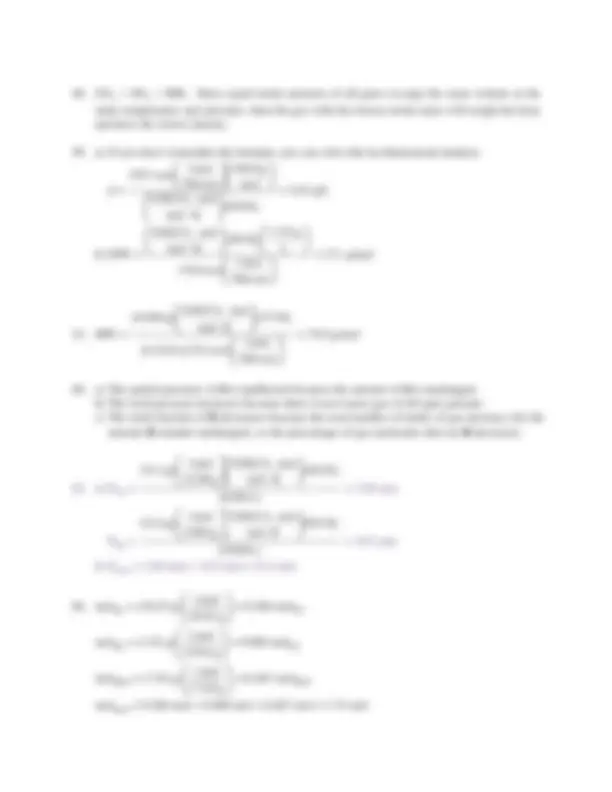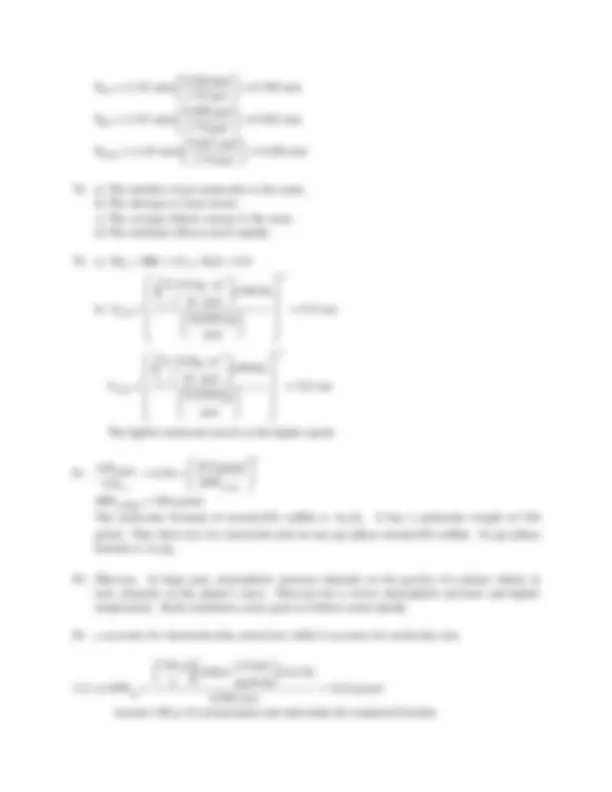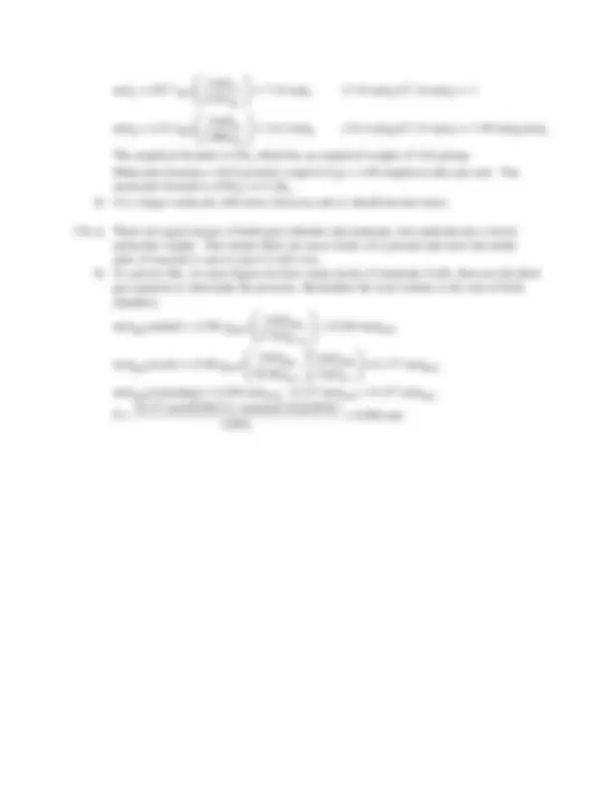





Study with the several resources on Docsity

Earn points by helping other students or get them with a premium plan


Prepare for your exams
Study with the several resources on Docsity

Earn points to download
Earn points by helping other students or get them with a premium plan
Community
Ask the community for help and clear up your study doubts
Discover the best universities in your country according to Docsity users
Free resources
Download our free guides on studying techniques, anxiety management strategies, and thesis advice from Docsity tutors
Material Type: Assignment; Professor: Castellani; Class: Principles of Chemistry I; Subject: Chemistry; University: Marshall ; Term: Fall 2008;
Typology: Assignments
1 / 5

This page cannot be seen from the preview
Don't miss anything!




Chapter 10 Homework Solutions
each other and will remain so. Assuming there is a space above the liquids in each
container, a little more of the liquid will evaporate in the larger container, but all of its
other properties will remain the same. Gas molecules are widely separated and that
separation will increase in a larger container. A number of properties change (e.g.
density), but most importantly pressure drops. This is because the gas molecules have
further to travel to strike a wall. Since gas molecules strike the wall less frequently, the
force acting on the wall is reduced and the pressure is lower.
b) As liquids, H 2 O(l) and CCl4 (l) molecules are in constant contact with each other. Water
is a polar molecule while CCl 4 is non-polar. Each would prefer to associate with other
molecules of itself. In the gas phase, molecules are widely separated, and except for
collisions have no interaction with other molecules. For this reason, gas molecules of
these two substances form a homogeneous mixture. This would be true of any collection
of gas phase molecules.
c) Liquid molecules are packed fairly tightly together, in other words each liquid molecule is
literally touching its next door neighbors. Gases are widely separated (hundreds of
molecular diameters or more). The masses of the vast majority of gases in a milliliter
volume would be too small to conveniently weigh.
1 atm
760 torr = 646 torr
b) (785 torr) (^)
1 atm
101,325Pa
760 torr
1 atm = 1.05 x 10 2 kPa
c) (655 mmHg)
760 mmHg
1 atm = 0.862 atm
d) (1.323 x 10
5 Pa)
101,325 Pa
1 atm = 1.306 atm
e) (2.50 atm) (^)
10 Pa
1 bar
1 atm
101,325 Pa 5 = 2.53 bar
mmHg
atm
= 742.5 torr
Pgas = 742.5 torr - 107 torr = 636 torr (The pressure of the gas is higher than
atmospheric.)
b) Patm = (0.99 atm)
mmHg
atm
= 752.4 torr
Pgas = 752.4 torr + 8.7 torr = 761 torr (The pressure of the gas is higher than atmospheric.)
760 torr
1 atm (4.38 L) = (1.88 atm)V 2
b) T 1 = 21 ºC + 273 K = 294 K
follow reaction stoichiometry. Thus the total volume of ammonia formed is 2.4 L. (i.e. One
stoichiometric unit of gas is 1.2 L and there is one such unit of N 2 , 3 units of H 2 , and 2 units
of NH 3.
b) 22.414 L (This can be calculated by substituting 1 mol and STP conditions into the ideal
gas equation.)
c) V =
mol
L atm
mol K
atm
mol K
L atm 1 .50 mol 0. (^0821) (
b) T =
333 x 10 mol) mol K
L atm 00821
760 torr
1 atm 0325 L) 750 torr
c) P =
mol K
L atm 0 .0467 mol 0. (^0821) (
= 3.82 atm
d) mol =
mol K
L atm 00821
101,325Pa
1 atm
1 kPa
1000 Pa 557 L) 1 1.25kPa
= 0.232 mol
mass =
mol K
L atm
mol
760 torr
1 atm ( 2. 70 L) 1. 78 torr
= 5.0 x 10-^3 g
PN2 = (1.85 atm) (^)
174 mol
0366 mol
.
= 0.389 atm
PH2 = (1.85 atm) (^)
174 mol
0 .908mol
= 0.965 atm
PNH3 = (1.85 atm) (^)
174 mol
0467 mol
= 0.496 atm
b) The nitrogen is more dense.
c) The average kinetic energy is the same.
d) The methane effuses more rapidly.
b) UCO =
8.314 kg m
s K mol
kg
mol
2
2
1/ ⋅
= 515 m/s
UCl2 =
1/
2
2
mol
s K mol
8.314kg m 3
= 325 m/s
The lighter molecule travels at the higher speed.
Ar
sulfide
rate
rate = 0.28 =
½
MWsulfide
39.9g/mol
MWsulfide = 509 g/mol
The molecular formula of arsenic(III) sulfide is As 2 S 3. It has a molecular weight of 246
g/mol. Thus there are two molecular units in one gas phase arsenic(III) sulfide. Its gas phase
formula is As 4 S 6.
turn, depends on the planet’s mass. Mercury has a lower atmospheric pressure and higher
temperature. Both conditions cause gases to behave more ideally.
g
L atm
mol K
.984 atm
= 42.0 g/mol
Assume 100 g of cyclopropane and determine the empirical formula.
molC = (85.7 gC)
C
C
12.01 g
1 mol = 7.14 molC (7.14 molC)/(7.14 molC) = 1
molH = (14.3 gH)
H
H
1.008 g
1 mol = 14.2 molH (14.2 molH)/(7.14 molC) = 1.99 molH/molC
The empirical formula is CH 2 which has an empirical weight of 14.0 g/emp.
Molecular formula = (42.0 g/mol)(1 emp/14.0 g) = 3.00 empirical units per mol. The
molecular formula is (CH 2 ) 3 or C 3 H 6.
b) It is a larger molecule with more electrons and so should deviate more.
molecular weight. This means there are more moles of it present and since the molar
ratio of reaction is one-to-one it is left over.
b) To answer this, we must figure out how many moles of ammonia is left, then use the ideal
gas equation to determine the pressure. Remember the total volume is the sum of both
chambers.
molNH3(initial) = (5.00 gNH3)
NH
NH
1703 g
1 mol
= 0.294 molNH
molNH3(used) = (5.00 gHCl)
HCl
NH
HCl
HCl
1 mol
1 mol
3 6.46g
1 mol = 0.137 molNH
molNH3(remaining) = 0.294 molNH3 - 0.137 molNH3 = 0.157 molNH